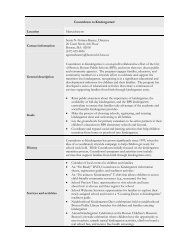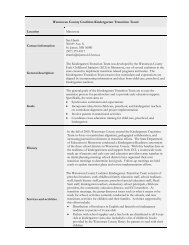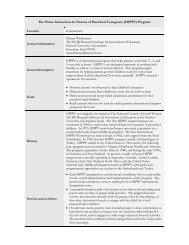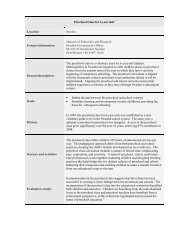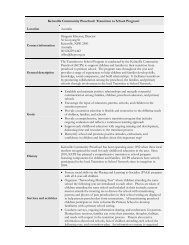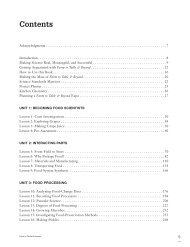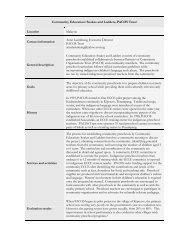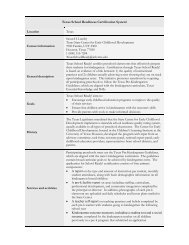Proceedings of the Fourth Annual Teachers College Educational ...
Proceedings of the Fourth Annual Teachers College Educational ...
Proceedings of the Fourth Annual Teachers College Educational ...
You also want an ePaper? Increase the reach of your titles
YUMPU automatically turns print PDFs into web optimized ePapers that Google loves.
esearch suggesting that many high-achieving Black students are accused <strong>of</strong> “acting White,” (Fryer and<br />
Torelli, 2005; Bucholtz 2001).<br />
As a result <strong>of</strong> this environment, most schools present an inversion <strong>of</strong> Black students’ fictive social identity<br />
(Fordham, 1991) relating to boundary maintaining factors in social interactions with white students. This<br />
mechanism allows Black students to identify “real” versus “spurious” members <strong>of</strong> <strong>the</strong>ir social group.<br />
According to Bishop, incorporating cultural history and minimizing <strong>the</strong> perception that students must<br />
“choose” between <strong>the</strong>ir Black identity and a desire for academic success are keys to avoiding dysfunction<br />
and raising credibility in education (Fordham, 1991). Eglash’s culturally situated design tools (CSDTs)<br />
rely on <strong>the</strong>se two concepts, and <strong>the</strong> design <strong>of</strong> <strong>the</strong> technology works towards <strong>the</strong> cultural and historical<br />
education <strong>of</strong> students while allowing <strong>the</strong>m to maintain <strong>the</strong> identities (Eglash et al., 2009). His research<br />
shows that this approach produces fur<strong>the</strong>r benefits beyond enhancing student interest, such as<br />
combating stereotypes, reinforcing student identity, and by combating notions <strong>of</strong> “primitivism” and raciallybased<br />
<strong>the</strong>ories <strong>of</strong> “natural ability.” He states that “African fractals in <strong>the</strong> classroom might help guard<br />
against an overemphasis on biological determinism, which has been found adversely to affect<br />
ma<strong>the</strong>matics learning,” (Eglash, 2005). Clearly, <strong>the</strong> integration <strong>of</strong> credible multicultural material with<br />
traditional American ma<strong>the</strong>matics education produces many benefits to learning, student interest, and<br />
social identity, and succeeds in capturing <strong>the</strong> attention <strong>of</strong> students and improving academic interest.<br />
Eglash and his team and his team at Rensselaer Polytechnic Institute have created a suite <strong>of</strong> culturally<br />
situated design tools, or CSDTs, designed to generate enthusiasm and improve student learning in<br />
ma<strong>the</strong>matics within cultural and historical simulations.<br />
These design tools draw considerable power from <strong>the</strong>ir credibility in <strong>the</strong> classroom. “CSDTs provide a<br />
potent space for students to reconfigure <strong>the</strong>ir relations between culture, ma<strong>the</strong>matics, and technology,<br />
and for anthropologists to carry out research in <strong>the</strong>se same domains,” (Eglash et al., 2009). These tools<br />
explore <strong>the</strong> relationship between youth identity and culture through interactive s<strong>of</strong>tware simulations <strong>of</strong><br />
cultural arts with underlying ma<strong>the</strong>matical designs, coupled with historical context. They also have <strong>the</strong><br />
added benefit <strong>of</strong> helping students better relate to math concepts through <strong>the</strong> use <strong>of</strong> culturally-specific<br />
imagery, and support key aspects <strong>of</strong> multicultural identity.<br />
Credibility <strong>of</strong> Culturally Situated Design Tools<br />
The credibility <strong>of</strong> CSDTs begins with context. According to Warnick, source credentials and reputation<br />
have become less important in <strong>the</strong> credibility <strong>of</strong> online information. She argues that it is advisable “to<br />
rethink <strong>the</strong> modernist conception <strong>of</strong> credibility as reliance on <strong>the</strong> message source and to a shift to a<br />
framework for judging credibility <strong>of</strong> messages that arise in <strong>the</strong> context <strong>of</strong> a distributed field <strong>of</strong> production<br />
oriented to specific purposes, functions, and values,” (Warnick, 2007). Therefore, part <strong>of</strong> <strong>the</strong> credibility <strong>of</strong><br />
CSDTs is <strong>the</strong>ir contextual notions <strong>of</strong> cultural heritage, visual design, and authoritative authorship (<strong>the</strong><br />
endorsement <strong>of</strong> <strong>the</strong> National Science Foundation is prominent on <strong>the</strong> CSDT main web site). In relation to<br />
this, Fogg discusses how Web sites will have more credibility if <strong>the</strong>y highlight <strong>the</strong> people or organization<br />
behind <strong>the</strong> content and services provided. He also shows that credibility perceptions will be enhanced if a<br />
Web site makes it easy for users to check outside sources to verify <strong>the</strong> accuracy <strong>of</strong> site content (Fogg,<br />
2003). The CSDT web site accomplishes both <strong>of</strong> <strong>the</strong>se tasks through references and by highlighting<br />
authors and partner organizations. Fogg identifies this as reputed, or “third party” credibility. While most<br />
users approach computing technology with “a preconceived notion about credibility, based on general<br />
assumptions about what is and is not believable” (Fogg, 2003), <strong>the</strong>y will re-evaluate <strong>the</strong>ir beliefs about <strong>the</strong><br />
credibility <strong>of</strong> a system after initial use and firsthand inspection.<br />
Fogg contends that technology that is viewed as trustworthy will have increased powers <strong>of</strong> persuasion,<br />
and that “sources that argue against <strong>the</strong>ir own interest are perceived as being credible,” (Fogg 123). The<br />
user must also have a perception that <strong>the</strong> information <strong>the</strong>y are receiving is fair and unbiased. This is<br />
perhaps one <strong>of</strong> <strong>the</strong> most relevant and powerful sources <strong>of</strong> credibility for CSDTs: <strong>the</strong>ir incongruity with<br />
traditional American education and relation to cultural identity. It is entirely possible for a student to<br />
perceive that <strong>the</strong> approach <strong>of</strong> CSDTs, <strong>of</strong>fering reinforcement to Black fictive kinship or o<strong>the</strong>r cultural<br />
identifiers, is directly counter to <strong>the</strong> approach <strong>of</strong> <strong>the</strong>ir previous schooling. This also speaks to Fogg’s<br />
47



